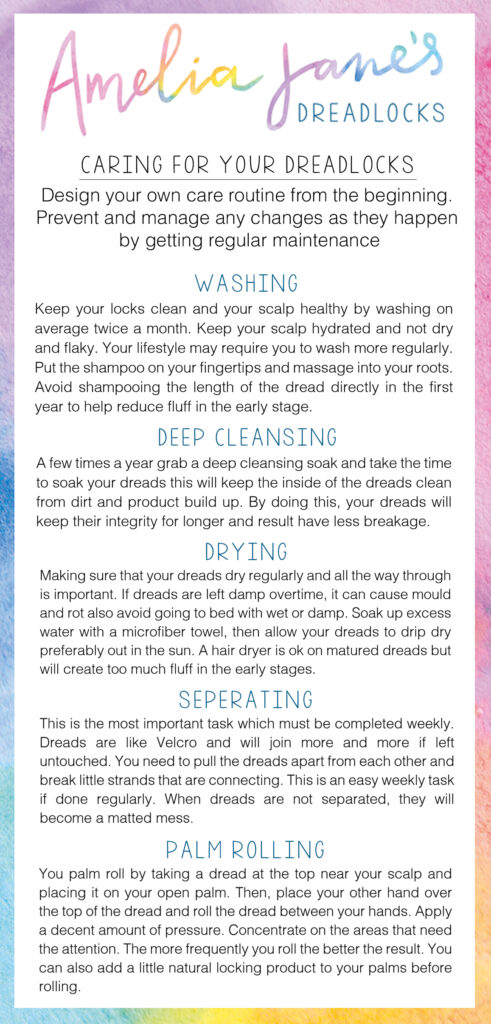Dreadlock Information
Visual Q&A's
Method and Our Style
We use the crochet hook method to create our dreads, our style looks neat and consistent all the way down. We avoid doing dreads too tight to the scalp to avoid scalp stress which promotes healthy hair and minimises dandruff and the risk of developing alopecia over time, this also means less pain and more comfort. The only products sometimes used when creating locks is for Type 1 hair which is extremely soft, shiny and straight. We use a dreadlock locking dust to help the hair grip and hold. For extensions we use real human hair only.
Preparing for your booking
Start by thoroughly reading all the information on this page to load up on some dread knowledge, know how to prepare for your booking and know what to expect for your dread journey. Use this knowledge to match your expectation correct service for you. If you have any questions after reading this page, please contact us on 0424654446 or hello@ameliajanesdreadlocks.com
To prepare your hair and scalp for dreads. Start backing off on how often you wash your hair, this will encourage your scalp to regulate it’s oils and help control scalp dryness. Leaving natural oils on your head longer is amazing hydration for hair strands and strengthens the integrity of your hair follicles. This step also starts to prepare you for any itching you may experience. You can also Purchase and start to use a Dreadlock shampoo, making sure you find one that works for you and does not cause any discomfort, dryness or reaction Stop using conditioner and start using a hydration product instead, this will create a more textured grip on the hair strands better suited for holding locks in place but will keep your hair stands heath and hydrated. Just remember to brush the knots out every day.
If you have a long day booking prepare to sit for a long time, so make sure you have a comfortable chair to sit on and maybe some tv shows or movies to watch, even though we will probably talk the whole time! How long your appointment will takes depends on what you book for and your hair type, thickness and length. For long bookings please ensure you have easy pre-made food or snacks readily accessible so we can work the whole appointment.
After you have book in using the booking form you will receive a confirmation email along with a confirmation text message. Please read and follow all instructions before your appointment. to make any changes to your booking please contact us on 0424654446
How to care for your dreads
For a long and healthy dread journey we recommend following the advice below. These care techniques if used correctly can also help guide your locks to form and lock in a particular desired style. Design your own care routine and get into good habits from the beginning.
Professional Maintenance
How often you choose to have maintenance is your personal choice. Dreads will lock and mature over time whether you get maintenance of not. However, you can prevent, and manage any problems as they happen by getting regular check-ups and keeping them tidy and neat during the first few years. Most clients book in for maintenance every three months. You will notice the longer you have dreads the less maintenance they will need, and eventually you will only need professional maintenance to get the roots tightened!
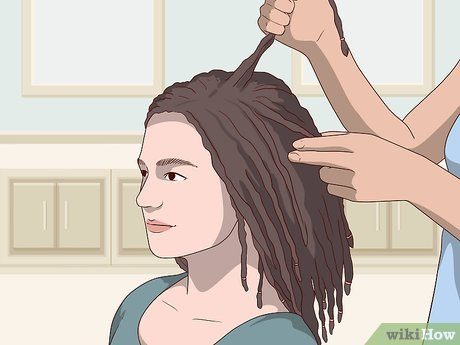
Washing
Keep your locks clean and your scalp healthy by washing your locks on average twice a month. It is important to note that your lifestyle may require you to wash your dreads more regularly in order to keep them clean. Washing less frequently allows your scalps natural oils to nourish your roots, and results in overall healthier hair!
Watch your scalp and adjust your routine according to your lifestyle. It is important to find a dreadlock shampoo that agrees with you as your scalp needs to stay hydrated and healthy and not dry and flaky. Put the shampoo on your fingertips and massage into your roots. Take time to massage and really stimulate the hair follicles which will deep clean any oil glands, promote hair growth and open pores. Avoid shampooing the length of the dread, and just focus on the roots directly in the first year to help reduce fluff until they have matured and locked.
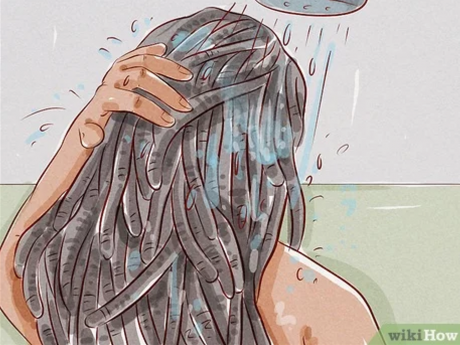
Drying
Wrap dreads in a micro towel and then allow to drip dry. Making sure that your dreads dry regularly and all the way through is very important. If dreads are left damp overtime, it can cause dread rot and mould. Wrap your dreads and a microfiber towel an allow to soak up excess water for 15 minutes first, then allow your dreads to drip dry preferably out in the sun and wind. A hair dryer is ok on matured dreads but will create to much fluff in the early stages. If you have a lifestyle or a job where your dreads are constantly wet or damp having a good washing care routine is extremely important.
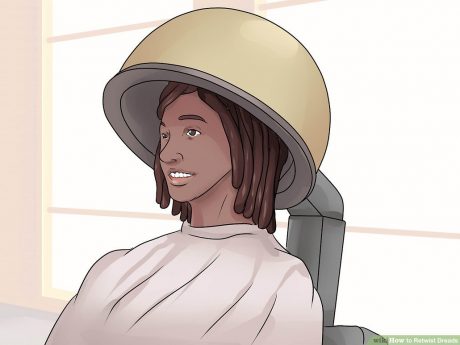
Deep Cleanse
A few times a year grab a deep cleansing soak and take the time to soak your dreads by keeping the inside of the dreads clean from dirt and product build up which prevents any smells or risk of developing rotting or mouldy dreads and avoid going to bed with wet or damp. By doing this, your dreads will keep their integrity for longer and have less age breakage. Avoid going to bed with wet or damp dreads as this constant to regular damp state can result in mould and eventually lead to rotting dreads.

Plam Rolling
You palm roll by taking a dread at the top near your scalp and placing it on your open palm. Then, place your other hand over the top of the dread and roll the dread between your hands. Apply a decent amount of pressure, and this will vary with the reason you are palm rolling. For more mature dreads with lumps and bumps, you want to apply more pressure and concentrate the time on the areas that need the attention. The more frequently you roll the better the result. You can also add a little natural locking product to your palms before rolling.
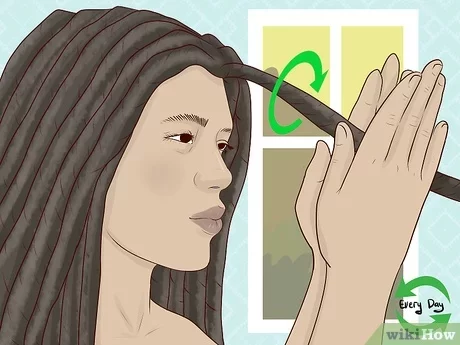
Separating Dreads
Out of all the self-maintenance care processes this is the most important task which must be completed weekly. Dreads are like Velcro and will join more and more if left untouched. You need to pull the dreads apart from each other and break only little strands that are connecting. This is an easy weekly task if done regularly. When dreads are not separated and have matted together, we can fix it at your maintenance appointment, just be sure to add it to your booking as it will take extra time. However, sometimes we need to use scissors to separate and or break a lot of hair which weakens the dread. This process can sometimes hurt.

What to expect
The process from new baby on the way to having fully matured adult locks really is a journey. Your lifestyle, care routine and your hair type all play a large part in your dreads development an end result. Below is a guide of what you can expect along the way.
Fluff can be the most frustrating aspect of new dreads. All dreads will always have a degree of fluff but new dreads that have not yet locked will be quite fluffy for some time until the dreads mature and stay in a locked state. No one avoids this stage and there are things we can do to help. Professional maintenance pulls all the loose hair strands back into dreads and has amazing, neat results. Palm rolling combined with some locking product can speed the process up as well as using silk pillowcases. Do not use a blow dryer, do not rub them dry with a towel and frequent hat use can all make fluff worse. In saying that, if you want to be more carefree and choose not to worry about the fluff, they will not fall out they will in time come in and lock tightly together.
As dreads go through the locking process and tighten, they move around a lot and one side will lock at a different rate to the other side. This causes the opposite side to ‘blow out’ that is a loop of hair. They are pulled in with a crochet hook at your professional maintenance appointments. Different hair types and lifestyles can change how many loops you get. Lumps are caused when the loops are pulled back in and it thickens in that area, or when wavy and curly hair types cause the dreads to twist. If left alone and allowed to form lumps they can create beautiful personality filled dreads with so much character.
New dreads can find softer spots where the hair has not yet locked – but give them time! If you have extensions, they may have a weak spot where they are connected, and this must be and can be fixed at your maintenance appointments. Bleach and chemical products that destroys the hair strands by breaking them down can also create weak spots and holes in your locks and over time dreads may break off. Older aged locks will become dryer and ends sometimes shed and break off.
If dreadlocks are not regularly separated, they will join to the dread next to them and will become friends, if left will eventually become lovers. This creates what we call branches, it is avoidable by regularly separating your dreadlocks. Branching is only recommended for mature locks. If you do not regularly separate your locks at the roots you will end up with a big matted messy that will need to be ripped or cut apart at your maintenance appointment, this is both painful and costs extra, it is bad for your locks and looks very bad.
Closed ended dreads over time will grow little tails – this is just loose hair coming out of the bottom. Pull them back in with a crochet hook or just snip them off if they are smaller. For a natural free formed feel just let the tails grow, they can also assist water drainage.
Products
The use of products on dreadlocks is a controversial topic and we will explain why. Misuse of products can potentially cause build-up which prevents the lock from fully cleaning and may slowly break down the dreads from the inside. If used properly, products can help speed up the locking process, minimise the fluffy stages, assist with itchy or dry scalps and hydrate locks. Follow the advice given here and at your appointments and we can help you safely use products if desired.
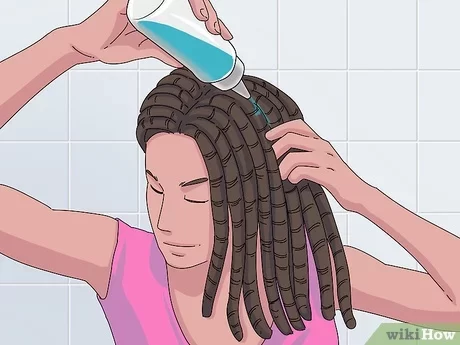
Cleansing products made for dreadlocks are going to have the best results. They are designed and formulated with natural ingredients that break down oils and build up with antibacterial properties which is very important for dreads. You can even get some specifically designed to help locking new dreads.
Some people’s scalps are naturally drier and can be prone to dandruff. Sometimes, dreadlocks can irritate and flare up these conditions. To hydrate and stop it you will have to find what works for you best. Change your shampoo can help and washing less or more often can affect the state of the scalp. 50% of clients will experience some, to a lot of itchy, flaky dandruff. Be patient and give your scalp time before trying new products.
These are the products you must use correctly. A small amount of locking gel can be warmed up by rolling the gel between your palms while palm rolling. Use the correct amount and do not use too frequently between washes. It is important to do deep cleansings soaks a few times a year to break down and dissolve the build-up. Locking products should not be used for long periods of time.
More Question
15cms is the minimum length requirement for both creation and extensions.
Dying your locks an using chemicals like toners and pigments will have the same effect as it
Interlocking is a controversial dread locking technique used all over the world. It is when the base of the dreadlock is parted at the root, the end of the dread is then threaded through and pulled tight. We can interlock your dreads upon request however we do not recommend doing it yourself. Interlocking can cause your dread to split into two and can create holes if done incorrectly.
This will depend on the thickness of your hair stands and the amount you have. The thinner in both aspects, the more length you will lose. There are a few maintenance care techniques that you can do to help reduce the amount of shrinkage during the locking process as they mature.
Yes dreadlocks can be removed you can unpick and comb them out we do provide this service however it takes time patience and is costly. we recommend starting yourself and giving us a call when you can not longer continue. Contact us for advise on how to remove.
If you get lice while you have dreadlocks you can still keep your dreadlocks. To kill the lice, you will have to be on top of it every day using the right products. However, you will not be able to comb the eggs out, so you’ll have to consistently kill the lice as they hatch until all eggs and lice are dead.
First let’s talk about what causes baldness and hair loss.
Ageing: This is the most common reason you could notice balding. Hair loss affects dreadlocks the same way they affect non-dread hair.
Traction alopecia: This is hair loss that occurs when you pull on your hair too tight. Dreadlocks can also cause scalp stress when there is too much weight pulling down or can happen if the regrowth maintenance is being tightened too tightly or too often, or if dreads are being pulled tightly into certain repetitive styles. Bad scalp condition or medical conditions: Some medications and medical conditions can cause hair loss. Speak to your doctor about how to deal with this.
Things to look out for: *redness *itchy flaking or blistering skin *thinning roots.
Open ends are when we leave some hair un-dreaded at the ends, they have a very softer natural feel and drain the water faster. Closed ends look neater and tidier usually preferred by males
Brick Style is a carefully pre-sectioned square formation designed to allow each dread to fall nicely in between the two dreads below. It looks clearly sorted and organised.
Dimond sections is a more intricate pattern with a larger sectioning coverage so best suited to thicker dreads.
Free formed sectioning is a more carefree and random way of achieving a more natural look. All dreads will vary in size and placement.
